Agrimonia, AgrimonyChinese Agrimony, Xian He Cao 仙鹤草Xian He Cao (TCM)Ghafis (Unani) |

|
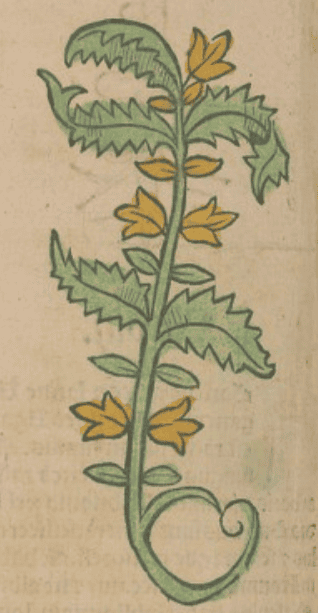
|
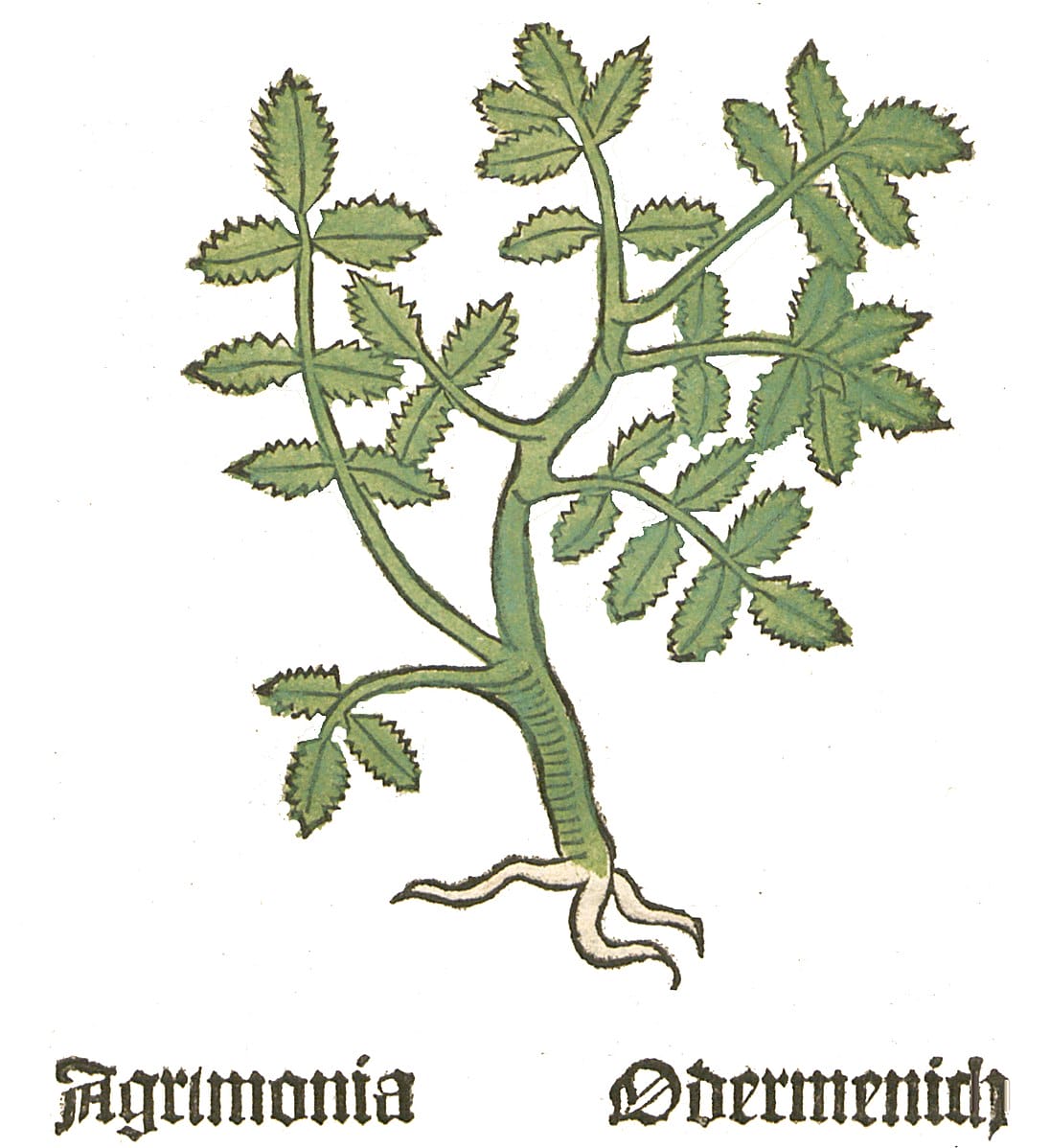
|
|
Ortus Sanitatis, Meydenbach, 1491 |
Herbarius Moguntinus, 1484 |
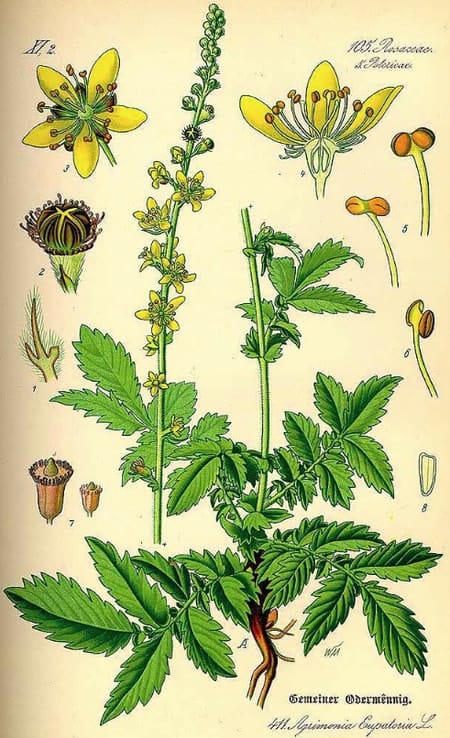 Agrimonia eupatoria
Agrimonia eupatoriaThomé, O.W., Flora von Deutschland Österreich und der Schweiz, Tafeln, (1885)
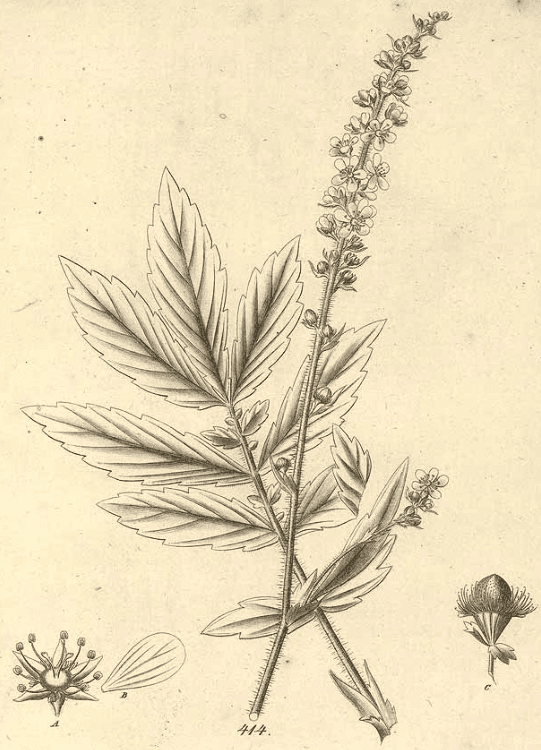 Agrimonia pilosa, used in TCM
Agrimonia pilosa, used in TCMReichenbach, H.G.L., Iconographia botanica seu plantae criticae, (1823-1832)
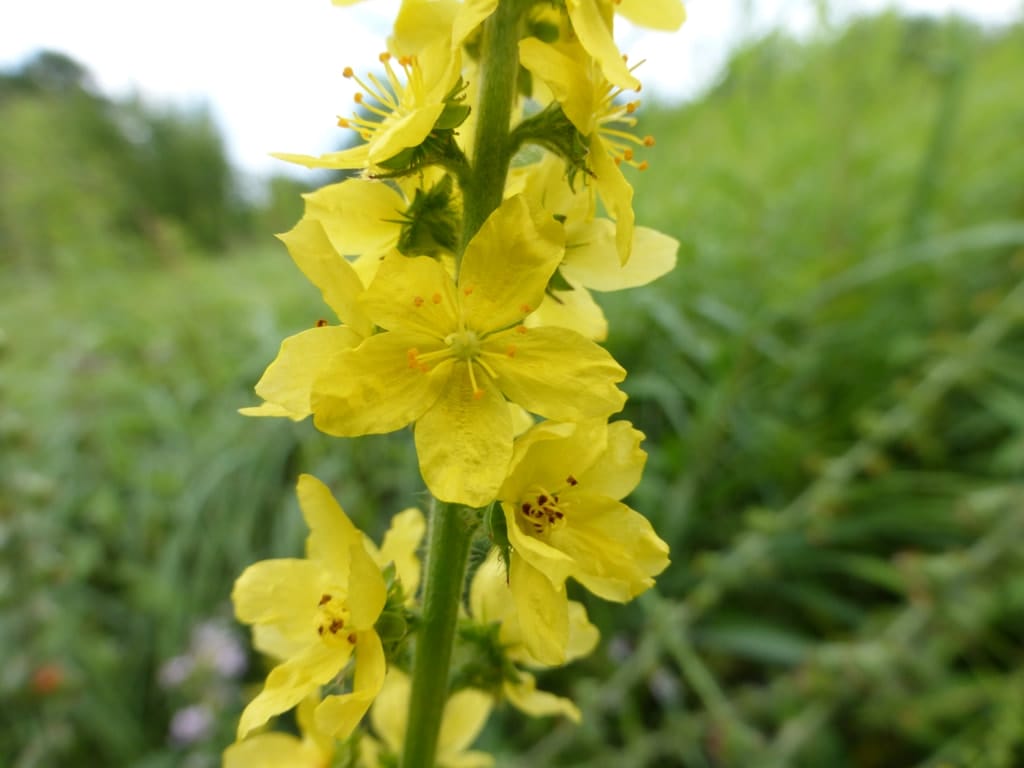 Agrimonia eupatoria
Agrimonia eupatoria(Photo by Ludwik Polak) (Wikimedia) |
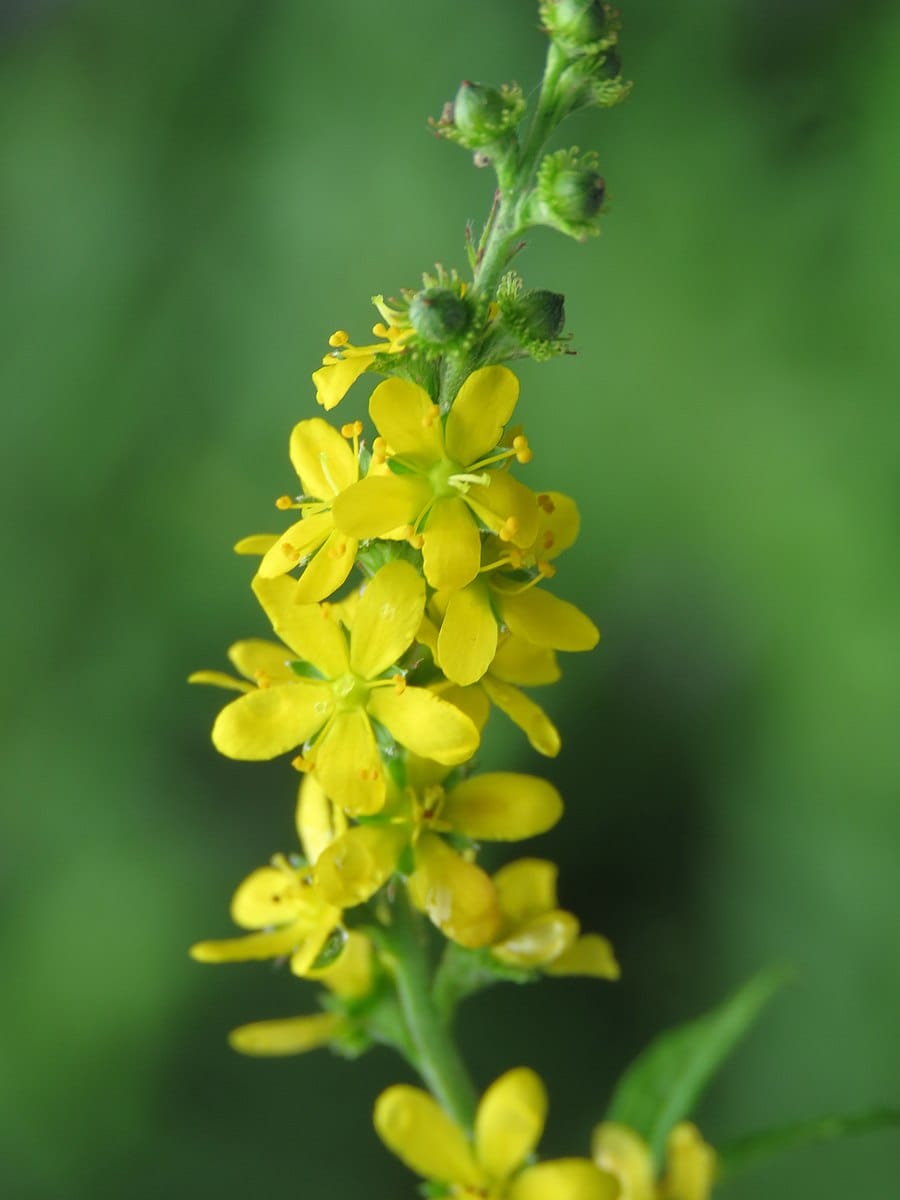 Agrimonia pilosa
Agrimonia pilosa(Photo by Vinayaraj) (Wikimedia) |
Eupatorium
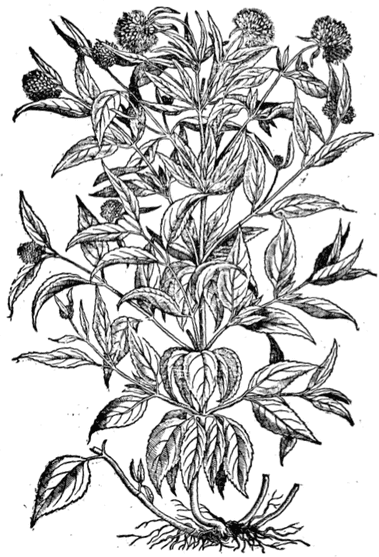
|
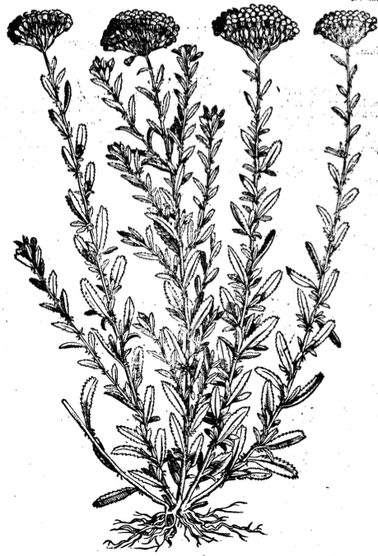
|
New Kreuterbuch, Matthiolus, 1563
Botanical name:
Agrimonia eupatoria
A, pilosa and A. nipponica are used in TCM
Eupatorium of the Arabs are different plants with similar functions to Agrimony. Agrimony was generally used for them in Europe.
Parts used:
Herb; dehydrated Juice
The buds of the Chinese variety are preferred for Worms.
Temperature & Taste:
Neutral (Mildly Warm), dry; Bitter, Sour
thin, opening, cleansing, strengthening
Classification:
2A APERIENT MEDICINES. 2C INCIDERS. 2F. PURIFYING. 2P. HEMOSTATICS. 2T. GLUTINATE
3B. FEBRIFUGE & ANTIPYRETIC. 3C. ALEXIPHARMICS. 3E. DIURETIC. 3O. EMETIC
4e. STOMACHIC. 4f. SPLENETIC. 4g. HEPATIC
TCM:
L. Stop Bleeding
Uses:
1. Benefits the Liver, Clears Heat and Damp:
-Salmon said it ‘strongly fortifies the Liver’
-Culpeper said it is ‘admirable remedy for such whose Livers are annoyed by heat or cold’.
-Jaundice, Liver Abscess, Cholecystitis, Acute Hepatitis, Cirrhosis etc.
-due to the beneficial effect on the Liver, it can be useful in various chronic diseases
-obstruction of the Liver or Spleen
2. Moves the Blood, Resolves Stasis, Resolves Swellings and Masses: (TCM, West)
-Bruising, Trauma, Dislocation, Blood Stasis
-obstructed Menstruation
-Cancer: Wirtzung (1598), among others, said the juice of Agrimony is ‘much commended for this disease’; it can ‘cause the good flesh to separate from the bad flesh’.
-related Chinese species is also used in Cancer Treatment
-strong decoction or extract has been found very effective for the severe pain of Cancer.
3. Stops Leakage and Bleeding: (TCM, West)
-Fluxes (looseness and leakages) of the Bowels; Diarrhea and Dysentery, Mucus Colitis; Ulcerative Colitis
–‘Very beneficial to the Bowels, healing all inward Wounds, Bruises, Hurts, and other distempers’ (Culpeper)
-specific for Passive Bleeding
-commonly used in TCM for all types of Bleeding depending on the herbs its combined with
-Diabetes
4. Clears Damp-Heat, Promotes Urine:
-Edema, Cystitis, stoppage of Urine, Lumbar pain; ‘makes them urinate clear speedily’. (Culpeper)
5. Clears Phlegm, Stops Cough:
-Cough, Bronchitis, Catarrh, Wheezing
6. Clears Heat, Resists Poison: (TCM, West)
-Venomous Bites (since Dioscorides)
-Fevers including chronic and complex Fever
-Abscesses, Toxic Sores;
-“Agrimony most wonderfully expels Poison, and with great facility helps the Bitings of Venomous Beasts”. (Culpeper)
7. Benefits Qi and Blood:
-as a tonic in both East and West, primarily in Folk Medicine; related to its beneficial effect on the Liver
-in some areas of China it is used as a Qi tonic in exhaustion where it is called Tuo Li Cao 脱力草 (Loss-of-strength Herb) (Bensky)
-Anemia, Fatigue, Exhaustion
-Rickets and weakness in Children
8. Kills Worms and Parasites: (TCM, West)
-Worms, especially Roundworm and Tapeworm (TCM, West; proven effect)
-Trichomonas (in enemas)
-Malarial disorders (TCM)
–Schistosomiasis (TCM, proven effect)
-Agrimony bud or sprout is especially used in TCM
9. Externally:
-good in baths and enemas;
-topically for Dislocations and Joint Pain
-applied to various inflammations
-gargled for Sore Throat
-mixed with vinegar and salt and applied to Itch
-applied with Vinegar to Warts
-Malignant Ulcer (Weinmann, Phytanthoza iconographia, 1737)
-crushed fresh leaves are applied to Snake Bite (TCM, Fu Jian Min Jian Cao Yao [Fujian Folk Medicine])
Dose:
In Decoction: 3–15 grams (up to 30 grams. In TCM, mega-doses of 100–500 grams have occasionally been used);
Of the Powder: 1–3 grams. For Worms, 30–50 grams of Agrimony buds or sprouts are given in Powder (TCM).
Of the Dehydrated Juice: 250–500mg (up to 1 or 2 grams)
Note:
1. The similar use, appearance and chemical composition of the Agrimonia species used in the West and TCM means that these species can be considered synonymous.
2. Agrimony was used by the Europeans in place of Eupatorium of the Arab physicians.
Substitutes:
1. Maidenhair
2. Golden Rod
3. Avens
4. Ground Ivy
5. Rose
Main Combinations:
Agrimony & Camomile
Liver:
1. Liver Heat and Obstruction:
i. Agrimony with Barberry and Centaury
ii. Agrimony with Wormwood, Indian Spikenard, Rhubarb, Fennel seed (as in Syrup of Agrimony Mesue)
iii. Agrimony, Amomum, Wormwood, Costus, Bitter Almond, Aniseed (Hepatico Potio Mirabilis of Nicholas)
iv. Agrimony with Asparagus root, Couch Grass root, Raisins, Oregano, Rosemary, Mugwort, Fumitory, Rhubarb, Cyperus, Licorice (as in Tincture for Hepatic Obstruction)
2. Jaundice, Liver obstruction:
i. or Liver Tumors or Hardness, Agrimony with Aloe, Yellow Myrobalan (as in Pills of Agrimony Lesser of Mesue)
ii. or Chronic Fever, Agrimony with Rose, Indian Spikenard, Rhubarb, Licorice (as in Troches of Rose and Agrimony of Mesue)
4. Cholelithiasis, Agrimony with Horehound, Rhubarb, Restharrow (Pick)
5. Cholecystitis, Gall Bladder disease:
i. Agrimony with Dandelion, Tumeric, Barberry (as in Decoction of Dandelion)
ii. Agrimony with Chicory root, Maidenhair, Wormwood (as in Decoction for the Gall Bladder)
6. Hepatitis:
i. Agrimony, Gentian, Balm, Licorice
ii. Agrimony with Juniper berry, Cleavers, Yarrow, Centaury, Dandelion root (as in Decoction for Hepatitis)
7. Cirrhosis of the Liver, Agrimony with Spikenard, Licorice, Asarum, Senna, Barberry, Rhubarb, Cinnamon, Saffron, Agnus Castus, Cyperus rotundus (as in Troches for Liver Hardness)
Bleeding:
8. Bleeding:
i. Agrimony with Shepherd’s Purse
ii. Hemoptysis, Agrimony with Comfrey and Plantin
iii. Hematuria, Agrimony with Imperatae Bai Mao Gen (TCM)
iv. Hematuria, Agrimony, Ladies Mantle, Yarrow, Burnet, Rose, St. Johns wort, Comfrey, Plantain seed (Gazophylacium Medico-Physicum, Woyts, 1746)
v. Uterine Bleeding, Agrimony (Xian He Cao) with Cuttlefish bone (TCM)
vi. profuse menstrual bleeding, Agrimony (Xian He Cao), Eclipta Han Lian Cao, Burnet (Di Yu), Dryopteris Guan Zhong, Motherwort (Yi Mu Cao), Siegesbeckia Xi Xian Cao
vii. bleeding from Heat and Yin deficiency, Agrimony Xian He Cao with Rehmannia Sheng Di Huang
viii. Bleeding from Blood deficiency, Agrimony Xian He Cao with Paeonia Bai Shao and Rehmannia Shu Di Huang
ix. bleeding from serious Yin and Blood deficiency, Agrimony Xian He Cao with Ass Hide Glue (E Jiao)
x. bleeding from Spleen deficiency with Spleen not able to manage Blood, take Agrimony Xian He Cao with Gui Pi Tang.
Gastrointestinal:
9. Diarrhea, Colitis, chronic Bowel complaints:
i. Agrimony with Camomile (internally and in enemas)
ii. Agrimony with Tormentil
iii. Agrimony with Chebulic Myrobalan, Costus
10. Dysentery:
i. Agrimony decocted in water and wine
ii. Agrimony seed decocted in wine (Herbarium Horstianum, 1630)
Urinary:
11. Edema:
i. Decoction of Agrimony heals
12. Dysuria,
i. Dysuria, Agrimony with Black Cohoch, Pulsatilla (Ellingwood)
ii. with Edema, Agrimony with Rhubarb, Bitter Almond, Madder, Celery seed (as in Powder for Edema)
13. Incontinence:
i. Agrimony with Plantain seed
ii. Agrimony, Horsetail, Golden Rod
iii. Agrimony, Raspberry leaf, Oak bark
iv. Agrimony with Chicken Gizzard Skin (as in Powder for Incontinence)
v. Agrimony with Hemp seed, Shepherds Purse, Plantain, Knotgrass (as in Decoction of Hemp Seed)
vi. associated with Menopause, Agrimony, Black Cohosh, Raspbery leaf
14. Stones, Agrimony with Knotgrass, Shepherds Purse, Camomile, Horsetail (as in Decoction for Stones)
15. Diabetes, combine Agrimony with Nettle and Yarrow
Swellings and Tumors:
16. Scrofula, Lymphatic swellings:
i. Agrimony with Herb Robert, Horehound (as in Decoction Against Scrofula)
ii. Agrimony with Figwort, China root (as in Decoction of Figwort)
iii. Agrimony with Figwort, Cinquefoil, Meadowsweet (as in Electuary of Figwort of Avicenna)
17. Cancer:
i. Agrimony with Barberry, Burdock, Yellow Dock, Poke root, Camphor (The Medical Herbalist)
ii. Agrimony with Yellow Dock, Quassia, Woody Nightshade, Cinquefoil (as in Decoction for Cancer)
iii. Agrimony with Figwort, Mullein, Herb Robert, Ceterach, Tormentil (as in Decoction for Cancer of Fuller)
iv. Agrimony Xian He Cao with Bitter Orange (Zhi Ke), Toxicodendron Gan Qi, Pteropus Wu Ling Zhi (Flying Squirrel feces), Curcuma Yu Jin, Alum, Potassium nitrate, Nux Vomica (Ma Qian Zi) (as in the well-known Chinese Ant-Cancer Medicine Ping Xiao Capsules)
v. Colon Cancer: Agrimony, Scutellaria barbata, Lonicera (see research below)
Other:
18. Chronic Fever, Agrimony, Wormwood, Yellow Myrobalan, Dodder seed, Agaric, Aloe taken with Troches Diarrhodon and Troches of Rhubarb (as in Pil. Philagril of Mesue)
19. Rheumatoid Arthritis:
i. combine Agrimony with Nettle, Celery seed and Rosehip (as in Infusion for Rheumatoid Arthritis)
ii. Agrimony, Burdock, Raspberry leaf, Yarrow, Bogbean (½ oz. ea.), boil in a quart of water for 10 minutes, strain and take a wineglassful three times daily. (Slack’s Herbal, 1892)
20. Inflammation of the Breast, combine Agrimony with Betony and Vervain (The Physicians of Myddvai, translated by John Pughe esq., 1861)
21. Cough from Lung weakness, Agrimony with Hyssop, Ground Ivy, Coltsfoot, Elecampane, Licorice (Pharmacopoea Dogmaticum Resititua, 1622)
22. Consumption, Agrimony with Raspberry leaf, Barberry (as in Infusion for Consumption)
23. Anemia, Weakness, Exhaustion, Agrimony (50 grams), Chinese Dates (Da Zao) (10 in number), decoct. (TCM)
24. Pain and Inflammations of the Limbs, Agrimony juice, Fenugreek meal, Armenian Earth mixed with pig fat and applied. (Arnold de Villa Nova)
25. Cold and painful joints, decocted Agrimony with Elecampane and wash morning and night
26. Trauma, Wounds:
i. Agrimony with Mugwort, Angelica, St. Johns wort, Betony, Bugle, Comfrey, Plantain, Tormentil, Wormwood (as in Decoction for Wounds)
ii. Agrimony with Wintergreen, Sanicle, Strawberry, Mugwort, Ladies Mantle, Plantain (as in Vulnerary Tincture)
iii. Agrimony with Rue, Hyssop, Sage, Yarrow, Self Heal, Comfrey, Vervain, Rosemary, Betony (as in Ungentum Contra Casum from Antidotarium Speciale Wecker, 1588)
27. Dislocation, beat fresh Agrimony to a paste and apply topically. (The Secrets of Alexis, 1615)
28. Ointment for Back Pain, Agrimony with Mugwort, Betony (as in Ointment for Back Pain)
29. Ointment for Bruising and Congealed Blood, with Rosemary, Lavender, Marjoram, Sage, Yarrow, Costus, Wormwood, St. Johns wort, Rue, Tansy (as in Ointment for Congealed Blood)
30. As a gargle for Apthae, Pharyngitis and Sore Throat, Agrimony with Sage
Major Formulas
The Immortal Antidote
Opening Hepatic Decoction
Decoction for the Liver (Nicholas)
Decoction of Fumitory Compound
Purging Bitter Decoction
Syrup for Excess Menstrual Bleeding
Syrup of Agrimony Mesue
Powder for the Liver
Troches of Agrimony
Troches of Gum Lacca (Trochisci de Lacca) (Unani)
Troches of Rose and Agrimony (Mesue)
Confection of Rhubarb (Mesue)
Electuary of Figwort (Avicenna)
Pills of Agrimony Lesser (Mesue)
Pills of Agrimony Greater (Mesue)
Cautions:
Generally Safe.
1. In TCM it is not used in acute bacterial Diarrhea.
2. Rare side effects have been reported which may include nausea, vomiting, dizziness, cold sweats, chest oppression, palpitations. These are usually only reported in full-to-mega doses, sometimes used in TCM. Symptoms dissipate with cessation of treatment.
Main Preparations used:
Distilled Water, clarified Juice, Quiddonie, Syrup; Salt from the ashes
1. Quiddonie of Agrimony:
i. Juice of Agrimony, depurated (8 pounds), White Sugar (1 pound). Mix them to dissolve the Sugar.
Very good for the Liver; it opens the Liver and the Spleen, and strengthens them, Very good for Diarrhea, Consumption, Hemoptysis, or Hematuria. Also Urinary disorders, internal bruising and Rickets in children ‘causing them to out-grow their weak habit of body’.
Dose: 1–3 oz., taken 3 times daily for weeks for Rickets or Consumption. (Pharmacopoeia Bateana)
- Extra Info
-
Research
- Treatment Notes
‘There is a form of dysuria which affects women and often girls, especially those who are suffering from some form of dysmenorrhea or those in which the establishment of the menstrual function is accomplished only with great distress and with very many unpleasant or painful symptoms. It will be found that while this is due sometimes to an irritable condition of the bladder it is so often accompanied with hysterical symptoms and other evidences of uterine irritation or ovarian congestion, that the treatment must be such as will relieve both conditions. When the nervous system is excitable the desire may occur almost at the will of the patient and at certain times existing conditions will cause an immediate desire and the discharge of a large quantity of urine. At other times but a small quantity is passed and the patient will find it necessary to rise many times during the night to evacuate the bladder. The older physicians used agrimony to correct this condition. Some of the symptoms will be relieved by thuja, the sharp cutting pain will be benefited by hydrangea. Gelsemium will relieve a portion of the general nervous irritability. But one of our old writers claimed that agrimony will more effectually relieve the entire group of symptoms than any other remedy which he could prescribe. When he first used it he gathered the herb from the garden, and made a strong decoction of it, giving this in ounce doses every two or three hours. Later he prescribed the specific agrimony and obtained as nearly good results. In a number of cases he gave agrimony, macrotys and pulsatilla, and succeeded in correcting the entire train of symptoms. The proportions were about as follows: Agrimony, five drams, macrotys, one dram; pulsatilla, one dram; water to make eight ounces. If any of our readers have had experience with this remedy in the treatment of this distressing condition I should like reports of that treatment’. (Ellingwood’s Therapeutist, 1908)
